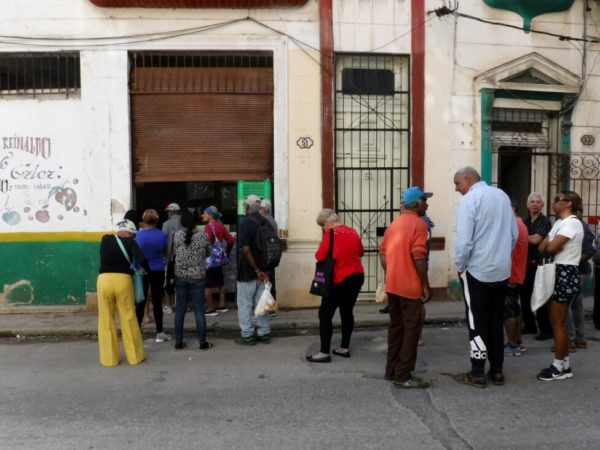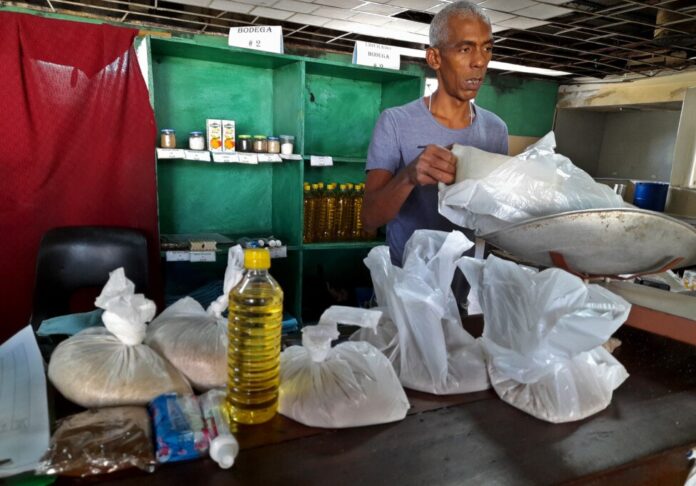
By Luis Brizuela (IPS)
HAVANA TIMES – Irregularities in the rationed distribution of foods in Cuba increase the vulnerability of individuals and families who face greater obstacles in accessing basic products amid a deep economic crisis, inflation, and agricultural production deficits.
“We’re halfway through the month and there’s no rice, beans, or coffee. They only sold two pounds of sugar,” showed retired Maricela Ballester as she exited a state-run store in the municipality of Centro Habana, one of the 15 that make up the Cuban capital.
“For months, they’ve been bringing things in little by little, and people need to eat every day. Even during the Special Period crisis -the period following the collapse of the socialist bloc in Eastern Europe and the Soviet Union, the island’s main trade partners-, the products were in the ration stores at the beginning of the month. It’s not like that anymore,” Ballester told IPS.
Since March 1962, Cuba has maintained a system of rationed food distribution through a booklet that provides each citizen with some subsidized rice, sugar, grains, eggs, coffee, oil, bread rolls, meat products, and hygiene products on a monthly basis.
Through the booklet, these products are sold in a standardized manner, and at subsidized prices for a population of 11 million inhabitants.
Although the quantities and variety have decreased greatly since its inception, it is considered a support for food needs, especially for those with low incomes and who do not receive remittances from abroad.
There are also special diets for vulnerable groups such as infants, pregnant women, and patients with various pathologies.
The rest of the food, including fruits, vegetables, and tubers, as well as hygiene products, must be obtained in state stores in foreign currency, poorly stocked agricultural markets, also from private businesses, cooperatives, self-employed workers, and in the illicit market, at very high prices.
Access to these markets is very difficult for people with low incomes in an inflationary environment.
In this country of 11 million people, 2023 ended with inflation of around 30%, according to official data.
“My pension of 1,750 pesos is enough to buy the rations, my medicines, and pay the bills at home. However, a kilogram of powdered milk costs 2,000 pesos and a carton (of 30 units) of eggs about 2,700 pesos. Even with the money my two sons give me, it’s not enough,” emphasized retiree María Virgen Blanco, who resides in the municipality of Arroyo Naranjo.
The average monthly salary in Cuba is equivalent to about $35 dollars, the minimum wage to 17.5 dollars, and the minimum pensions to 12.7 dollars, based on the official rate (120 pesos per dollar).
But the current exchange rate in the informal market (300 pesos per dollar), which dictates the prices of many foods, goods, and services to meet consumer needs, reduces the average salary to $13.80 dollars, the minimum wage to seven dollars, and the lowest pensions to $5.10 dollars.
For example, a kilogram of powdered milk is priced at the equivalent of 6.70 dollars on the illicit market, often the only place it’s available.
From the Vista Alegre neighborhood, in the eastern city of Holguin, accountant Maikel Batista confirmed to IPS that “since the second of the month they haven’t distributed the liter of milk” established for children aged two to seven.
“You go crazy looking for some fruit to make juice or powdered drinks so they can have breakfast and go to school,” he pointed out.
Father of two children, Batista indicated that “the rationed daily bread roll is also failing; they say it’s due to a lack of flour or electricity, but they don’t sell it. It’s impossible to buy it every day from private sellers, due to the price.”

History of the ration booklet
Cuba’s rationed distribution system sought to overcome the scarcity generated by the dispute with the US government, then the country’s main supplier, which, dissatisfied with the direction of the 1959 revolution, broke off relations in 1961 and imposed the embargo still in effect today.
Cuban authorities argue that the tightening of the embargo has influenced the deterioration of the economic situation.
They also refer to the island’s inclusion, since January 2021, on the list of countries that Washington considers sponsors of terrorism, which hampers access to sources of financing and foreign investments, due to the fear of banks in third countries of receiving large fines for accepting payments, deposits, or accounts from Cuban state companies in dollars.
The fall in the main sources of foreign currency, the impact of COVID, as well as errors and delays in the implementation of reforms initiated in 2011, have widened economic hardships.
At the same time, the distribution of basic products has become more irregular, especially over the past year, as the lack of liquidity delays purchases abroad.
Maintaining the rationed distribution requires about 1.6 billion dollars annually, according to official reports.
Traditional items in national production such as sugar and coffee now depend on imports.
In recent years, there have been declines in yields and insufficient harvests of tubers, grains, and rice attributed to multiple factors, including fuel deficits, lack of inputs, and organizational problems.
Financial difficulties in importing feed or its raw materials also determine very low productions of pork and eggs.
Measures to revitalize agriculture remain, so far, without tangible results in a country that produces barely 20% of the food it consumes.
The agricultural sector received only 2.6% of investments in 2022, compared to almost 33% for business services, real estate activities, and rentals, which includes new hotel construction, according to official statistics.
In addition to considering the above an investment distortion, economists urge redirecting some of those funds to other sectors, including food production.

End of rationing?
As part of the reform plan initiated more than a decade ago, it was proposed to eliminate the ration booklet in an orderly and gradual manner.
Economists recommend getting rid of this distribution mechanism, which they consider an expression of “egalitarianism,” as it benefits both those who need it and those who do not.
Others believe that the rationed system distorts the prices of essential foods and prevents the proper calculation of the value of goods necessary for subsistence.
Cuban economist Omar Everleny Perez Villanueva has estimated the cost of living in Cuba at 267 dollars per month for a family of two to meet basic expenses.
Some researchers estimate that at least a third of the island’s population lives in poverty with unmet basic needs and have warned of an increase in the precariousness of family living standards.
They classify pensioners, large families, single-parent families, households headed by women without stable employment, elderly people living alone without support from other relatives, and those who are unable to work due to disabilities or various conditions, as falling into this spectrum.
During a television interview in November 2023, President Miguel Díaz-Canel stated that his government is studying subsidizing individuals rather than products through “a methodology so that no one is left unprotected.”
However, the president also said that “even if we only subsidize individuals, we have to make food available, even for those who will not be subsidized, because you can’t just address the problems of those you are going to subsidize, of those who are supposedly in a more disadvantaged situation.”
When asked by IPS about the issue, several people agreed that the internal situation discourages eliminating the ration booklet as long as problems persist in the accessible production and commercialization of sufficient quantities and varieties of food.
“I think a majority of families in Cuba need those products. They last for a week or 10 days at most, but it’s better than nothing because with my current salary and prices, I couldn’t buy them,” estimated Gilberto Padrón, a sugar technician residing in the town of Jaruco, 40 kilometers east of Havana, in conversation with IPS.
It is estimated that an average family in Cuba spends more than 80% of its income on buying food.
“As long as there is scarcity and salaries and pensions are not enough to live decently, the majority will need the ration booklet. It is also a mechanism to distribute what little there is and prevent hoarding or speculation. Otherwise, only those with enough money will be able to buy,” Professor Georvis Santos told IPS, in Havana.
Sociologists believe that the subsidy process should be extended to people with fewer resources, without other options, and in poverty, perhaps starting from a self-request, and considering that someone with low income may receive remittances and increase their financial possibilities.
Read more from Cuba here on Havana Times.




